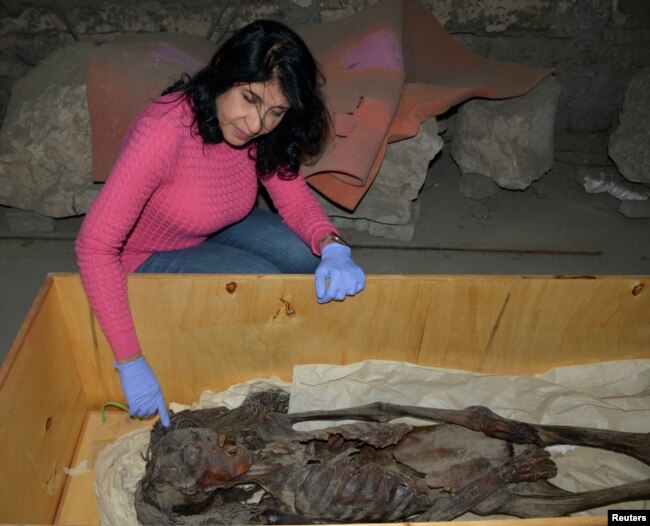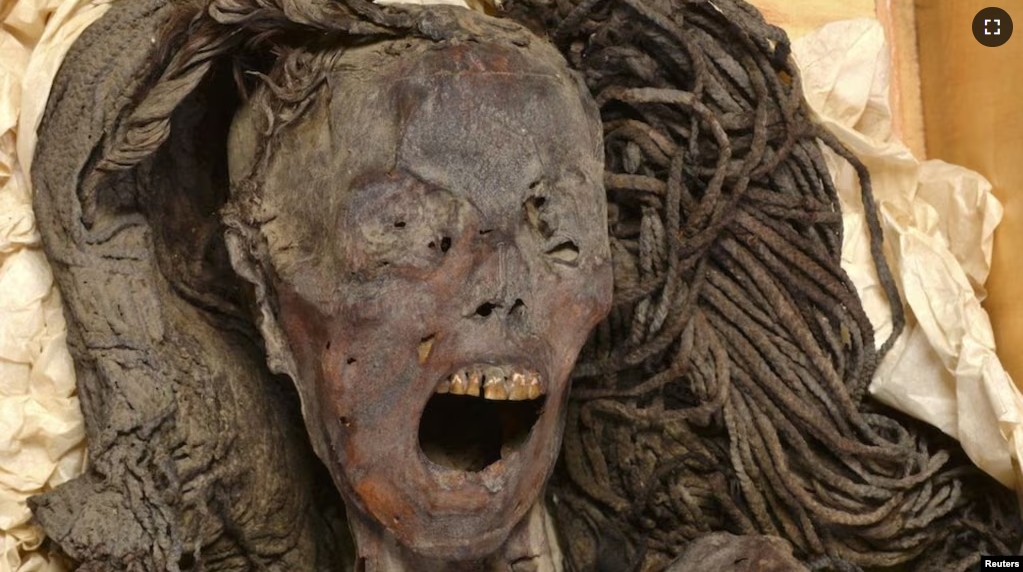Scientists now have an explanation for the mysterious remains of an ancient Egyptian woman who has her mouth open in what appears to be a scream.
Scientists used a special computer aided X-ray, or CT scan, of the woman’s body. What they found suggested that the so-called “Screaming Woman” mummy may have died in pain and experienced a form of muscular hardening known as a cadaveric spasm. This rare kind of spasm happens at the moment of death.
The examination found that the woman was about 48 years old when she died. Cairo University’s Sahar Saleem said she had lived with mild arthritis of the spine and had lost some teeth.
Saleem led the study that appeared recently in the publication Frontiers in Medicine.

The woman’s body was well-preserved although it had been embalmed 3,500 years ago. Embalmers used costly imported materials such as juniper oil and frankincense resin, Saleem added.
The ancient Egyptians considered preservation of the body after death important for securing a good existence in the afterlife. It was a custom to remove the internal organs during the mummification process. But the organ removals had not taken place with this woman.
Saleem said, “In ancient Egypt, the embalmers took care of the dead body, so it would look beautiful for the afterlife.”
She explained that embalmers were interested in closing the mouth of the dead. Embalmers kept the jaw in place by tying the jaw to the head. This prevented the normal jaw drop that occurs after death.
But the embalmers were likely not careless with the so-called “Screaming Woman.” They used high quality materials and gave her costly jewelry and a wig, Saleem said.
She added that this evidence “opened the way to other explanations of the widely opened mouth.”
The woman may have died screaming from pain. And the muscles of the face may have become tense to preserve this appearance “at the time of death due to cadaveric spasm,” Saleem explained.
She said that the full history of the woman’s death is unknown, adding the cause of her facial appearance cannot be known “with certainty.”
Cadaveric spasm is a poorly understood condition. It is thought to happen after severe physical or emotional suffering. The contracted facial muscles become tense and unmoving immediately following death.
Saleem explained that unlike the stiffening of muscles and joints that happens after death – “cadaveric spasm affects only one group of muscles, not the entire body.”
Asked whether the woman may have been embalmed while alive, Saleem added, “I don’t believe that this is possible.”
Saleem was unable to find out how the woman died.
The “Screaming Woman” was found in the ancient city of Thebes during a scientific search of the burial of a high-ranking official named Senmut in 1935.
The mummy was inside a wooden coffin in a room beneath Senmut’s family burial area. Her identity is unknown, but her costly jewelry shows her important position.
“She was likely a close family member to be buried and share the family’s eternal resting place,” Saleem said.
I’m John Russell.
Will Dunham reported on this story for Reuters. John Russell adapted it for VOA Learning English.
______________________________________________
Words in This Story
scream –n. to shout in a high voice or high pitch
mummy – n. a body embalmed or treated for burial with preservatives in the manner of the ancient Egyptians
spasm – n. an involuntary and abnormal muscular contraction
arthritis – n. inflammation of joints
preserve – v. to keep free from decay or decomposition
embalm – v. to treat (a dead body) so as to protect from decay
jaw –n. the bones that form the lower part of the mouth and which hold the lower teeth
contract –v. to increase in tension and become shorter or smaller
coffin – n. a box for burying a body
eternal –adj. lasting forever
